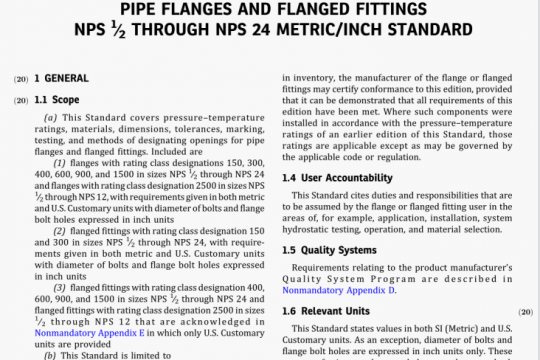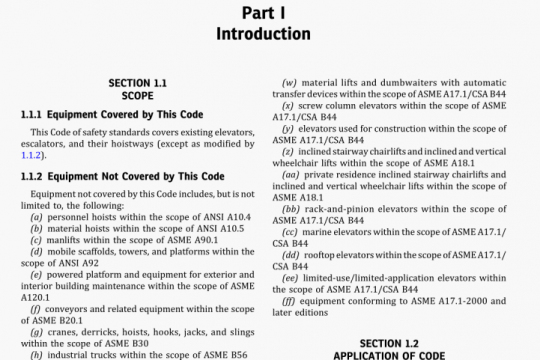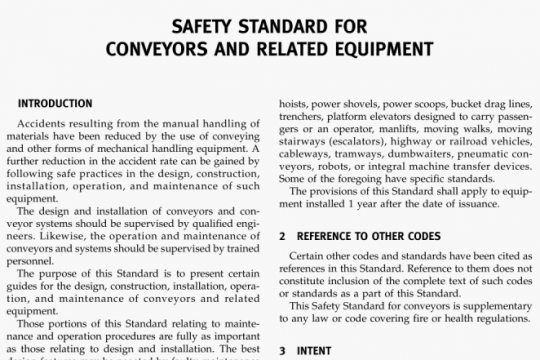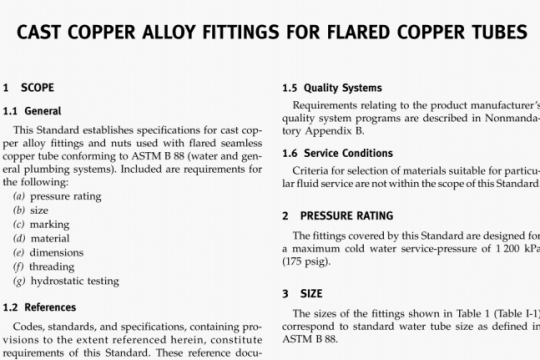ASME B16.1-2015 pdf free
ASME B16.1-2015 pdf free.Gray lron Pipe Flanges and Flanged Fittings.
(a) Classes 25 and 125 gray iron flanges and flanged fittings shall be flat faced (i.e.. without projection or raised lace) and finished in accordance with MSS SP-6.
(b) Class 250 flanges and flanged fittings shall have a 2 mm (0.06 in.) raised lace of the diameters given in Table 2 and finished in accordance with MSS SP-6. The raised face is included in the minimum flange thickness and center-to-lace dimension.
Center-to-Face Dimensions
Side Outlet Fittings. Side outlet elbows, side outlet tees, and side outlet crosses shall have all openings on intersecting centerlines. Long-radius elbows with side outlet shall have the side outlet on the radial centerline of the elbow.
(a) The center-to-face dimensions for straight-size 90-deg elbows, 90-deg long-radius elbows, 45-deg elbows, side-outlet 90-deg elbows, and double-branch elbows are shown in Tables 3, 4, and 5.
(b) Reducing 90-deg elbows, reducing 90-deg long- radius elbows, reducing side-outlet 90-deg elbows, and reducing double-branch elbows shall have the same center-to-face dimensions as straight-size fittings shown in Tables 3, 4, and 5 corresponding to the size of the largest opening.
(c) For 90-deg long-radius elbows with side outlet, the center-to-face dimensions of the side outlet shall be the same as dimension A in Tables 3, 4, and 5 br a straight-size 90-deg elbow corresponding to the size of the largest opening.
(d) Special-degree elbows ranging from 1 deg to 45 deg, inclusive, shall have the same center-to-face dimensions as those for 45-deg elbows; those over 45 deg and up to 90 deg, inclusive, shall have the same center- to-lace dimensions as those for 90-deg elbows. The angle designation of an elbow is the angle between the flange faces.
Tees, Crosses, and tateraLs
(a) The center-to-face dimensions for straight-size tees and crosses, with or without side outlet, and laterals are shown in Tables 3, 4, and 5.
(b) Reducing tees and reducing crosses, with or with out side outlet, and reducing laterals, NPS 16 and smaller, shall have the same center- to-face dimensions as straight-size fttings shown in Tables 3, 4, and 5 corresponding to the size of the largest opening. For NPS 18 and larger, if the outlet of a reducing tee; the branch of a reducing lateral; or the largest outlet of a reducing side outlet tee, reducing cross, and reducing side outlet cross is the same size or smaller than given in Tables 3,4, and 5 (short body pattern), the center-to-lace dimensions shown in these Tables shall be used. If a branch or any outlet is larger than shown in Tables 3, 4, and 5, the center-to-lace dimensions shall be the same as for the straight-size fitting shown in Tables 3, 4, and 5 corresponding to the size of the largest opening. Tees, crosses, and laterals, reducing on the run onl shall have the same center-to-face dimensions as straight-size fittings shown in Tables 3, 4, and 5 corresponding to the size of the largest opening.
(C) Tees reducing on both runs are generally known as bull-head tees and have the same center-to-face dimensions as straight-size fittings corresponding to the size of the outlet.
True V’s. Center-to-face dimensions for straight-size true Y’s are shown in Tables 4 and 5. Reducing sizes are considered special and should be made to suit conditions.
Reducers and Eccentric Reducers. The face- to-lace dimensions for all reductions of reducers and eccentric reducers shall be the same as given in Tables 4 and 5 for the largest opening.
Center-to-Face Tolerances
The following tolerances shall be permitted on all center-to-contact surface dimensions of fittings: Tolerances for contact surface-to-contact surface dimensions shall be twice those given below. Thc largest opening in the fitting governs the tolerance to be applied to all openings.ASME B16.1 pdf download.




